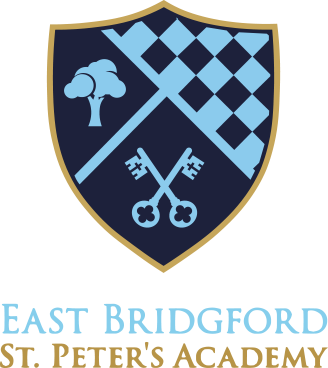Art
“Just make a mark and see where it takes you.”
By Peter H. Reynolds
What do we want Art to achieve?
At St Peter’s, we believe that Art and Design is a critical component of a well-rounded curriculum. Exploring the possibilities and making creations can be deeply fulfilling for children and enables them to ‘strive for life in all its fullness’. Art can help build memory skills, alongside other benefits such as self-discipline, intuition, reasoning, imagination, and dexterity. Ensuring that each child, irrespective of their ability is progressively taught to use creative tools and ideas will positively impact their self-confidence and support profound personal development.
At St Peter’s, we strive for children to explore, create and express themselves through Art.
We want them to experiment with different materials and techniques, reflect on their work, and make purposeful changes. Our aim is for pupils to engage in art with meaning, creating pieces that reflect their own thoughts and emotions, and that have personal or cultural significance.
We aim for Art to be a stimulating and challenging subject where children develop their own original ideas, not simply replicating others’ work, but putting their own creative stamp on every piece. We want them to take risks, problem-solve visually, and follow a process that values imagination, expression and reflection.
At St Peter’s, we want to instil a love of visual storytelling. Art allows children to explore the world and themselves, developing not only technical skill but emotional intelligence. Whether through drawing, painting, sculpture or mixed media, we want pupils to enjoy art as a vital part of life, supporting well-being, identity and connection. By carefully planning our Art curriculum, our intention is for every child to experience a wide range of artistic styles, artists, and cultural influences. We want Art to be a springboard for future illustrators, painters, designers, curators and creative thinkers.
Why is Art important to us?
We live in a world shaped by creativity and art. Teaching Art helps children develop the skills and mindset they need to understand and engage with the creative world around them. It builds important skills such as curiosity, perseverance, and confidence.
Art is not just about making things, it’s about thinking, planning, experimenting, and improving ideas. It encourages children to think creatively to solve problems and bring their ideas to life. Through Art, pupils explore a range of materials and techniques, including drawing, painting, and sculpting, gaining practical skills that are useful both inside and outside the classroom. At St Peters, it encourages children to “Take care” and produce work they are proud of.
Art also links with other subjects like history and science and often involves collaboration, helping children to share ideas, listen to others, and work as a team. Creating something with care gives children a strong sense of achievement and supports their personal development, which is central to everything we do at St Peter’s.
How do we develop knowledge and skills in Art?
Our Art lessons are carefully sequenced to help children build their knowledge and skills as they move through school. At each stage, children are introduced to a rich art vocabulary, which is taught clearly, built upon over time, and regularly revisited. Learning activities are designed to develop both creative expression and technical skills, in line with the National Curriculum. Children are supported to explore, plan and create their own artwork, select appropriate materials and tools, experiment with different techniques, reflect on their outcomes, and talk confidently about their artistic choices and processes.
As our children’s knowledge and understanding deepen, they become more able to analyse artwork, both their own and that of others, drawing conclusions based on visual evidence, personal response, and context. Throughout our teaching, we encourage children to ‘think like an artist’ by developing their creativity, visual awareness, reflective thinking, and confidence to adapt and refine their ideas.
Children develop and build their knowledge in five key areas:
- Drawing
- Painting
- Sculpture
- Printing
- Collage and Mixed Media
How do we develop knowledge and skills in Art?
Our Art lessons are carefully sequenced to help children build their knowledge and skills as they move through school. At each stage, children are introduced to a rich art vocabulary, which is taught clearly, built upon over time, and regularly revisited. Learning activities are designed to develop both creative expression and technical skills, in line with the National Curriculum. Children are supported to explore, plan and create their own artwork, select appropriate materials and tools, experiment with different techniques, reflect on their outcomes, and talk confidently about their artistic choices and processes.
As children’s knowledge and understanding deepen, our children become more able to analyse artwork, both their own and that of others, drawing conclusions based on visual evidence, personal response, and context. Throughout our teaching, we encourage children to ‘think like an artist’ by developing their creativity, visual awareness, reflective thinking, and confidence to adapt and refine their ideas.
How do we use assessment in Art?
Because Art is a practical and creative subject, we assess both the process and the outcome of learning. By evaluating children’s understanding and progress in key artistic concepts, we can guide future teaching and help pupils reflect meaningfully on their work. Art knowledge and skills are often observed ‘in the moment’, and assessment takes place through ongoing discussion, visual exploration, and focused tasks, both practical and reflective.
This approach allows teachers to spot and address misconceptions as they arise, supporting continuous progress. Teachers plan carefully for the specific skills and knowledge they want children to develop by the end of each project, and pupils are assessed against key questions through their verbal, written, and creative responses.
When we incorporate Art into our signature work, it plays an important role in bringing together learning across subjects. Children produce a high-quality final piece of work that showcases their creativity, understanding, and care, something they can be proud of and that reflects both their artistic journey and our "Take care" values.
How do we include and challenge all children in Art?
At St Peter’s, we create an inclusive and stimulating Art environment that values diversity, creativity, and individual expression. We adapt our teaching to meet the needs of all learners by using multi-sensory approaches, providing a range of materials and tools, and offering various ways for children to express their ideas, whether through drawing, painting, sculpture, collage, or digital media. We ensure our curriculum reflects a wide range of cultures and backgrounds, allowing every child to see themselves represented and celebrated. At St Peter’s, we foster a safe and supportive classroom where all students feel confident to take creative risks and where effort and exploration are valued. By taking care of each other, we work collaboratively at times to support one another, sharing ideas, offering constructive feedback, and learning together. To challenge all learners, we provide open-ended tasks that encourage individual interpretation and creativity, while developing higher-level thinking through reflection, questioning, and analysis. We will expose students to a broad spectrum of artists and art forms, including contemporary and global perspectives, to inspire and extend their thinking. Personalised goals and extension activities will help children grow at their own pace, while scaffolding and support will ensure everyone can succeed. Through this approach, St Peter’s will ensure that every child is included, engaged, supported, and challenged in their Art learning.
Useful Links

